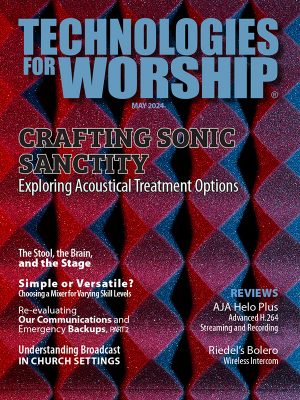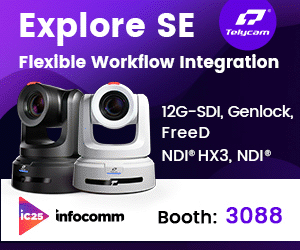
From the soaring acoustics of gothic cathedrals to the advent of amplified sound and electric instrumentation, sound reinforcement in houses of worship has come a long way since the sermon on the mount. Given the advances in technology since then, there are many important factors that should be considered when designing a versatile and effective wireless audio system that will meet the needs of contemporary worship spaces and ensure that the spoken word of worship leaders and music from worship musicians reaches everyone in the congregation.
One of the most important investments worship leaders can make regarding sound reinforcement is selecting the right wireless audio system. The myriad of available devices, configurations, and price-points can make these choices seem daunting — which is why it is best to start by identifying the specific needs of your space, services, and worship leaders. Prioritizing these key elements will ensure the selection of a wireless audio system that will serve your parish for years to come and make the difference between consistent, crystal-clear sound you can count on from service to service, or an ongoing headache that might have you praying for deliverance!
1/Tuning for the proper frequency
The first step in determining the requirements for any new wireless audio system for your worship space is to assess the existing RF (radio frequency) environment. It’s important to map out existing RF signals before deciding what new equipment to buy. In plain language, this means determining what competing frequencies may exist in your space and understanding the tuning range of your wireless transmitters and receivers. These competing frequencies can come from both interior and exterior sources and can be determined by using RF test equipment like a Spectrum Analyzer. Interior sources may include other electronic devices in your worship space, existing RF systems, video walls, lighting fixtures, etc. Exterior sources can include interfering signals from nearby digital television transmitters or other competing devices. Once you have a clear map of your RF environment, you’ll be able to select devices that can tune to clear RF spectrum within the environment. It’s important to note that the RF environment is not set in stone due to the dynamic nature of RF transmissions, and the possibility of changes to FCC regulations that dictate where wireless transmitters are allowed to operate. Given that, and for the sake of longevity, it’s worth considering wireless devices that offer an exceptionally wide tuning range. This allows for optimal selection of clean and reliable frequencies.
2/The needs of the many
Next, you will want to determine how many wireless microphones your services will need and how to prioritize these inputs in your overall system. The wireless system used by worship leaders can be a key part of this equation. There may be times during a worship service when the worship leader’s wireless microphone is the primary microphone in use and any technical difficulties can be very noticeable. You may want to place this system in the best available clear spectrum. At other times, wireless users can include worship musicians and other service participants. You’ll want to consider what manner of wireless microphones are planned for use – whether handheld, headset, or lavalier – as that will impact the type and number of transmitters and receivers you need. You also want to ensure you’re considering the needs of events held in the worship center outside of weekly services. This could be holiday events, community gatherings, etc. These events may require more wireless systems than usual. By considering all these various needs, you’ll not only ensure that your system can handle these events, but you’ll also have redundancies in place for your regular equipment and leave room for the system to grow as required by the needs of your congregation.
3/Straightforward control for versatile performance
Finally, you’ll want to consider how you are planning on operating this system and make it as user-friendly as possible. The best systems are straightforward to use and include redundancies to deal with potential problems – such as signal failure or interference. Recently, wireless systems become more compact, which is a benefit for worship spaces that may not have large, dedicated equipment rack space or are using a portable system that can be deployed in various locations. If you have a fixed audio mix position near the area where the wireless microphones will be used, you likely already have the space you need for a dedicated wireless location. However, if like many churches you are dealing with limited space and your sound technicians are volunteers, there are many options for designing a versatile portable system that can be used with minimal training by nonprofessionals. Many systems offer remote control options, for example companion apps for PC or mobile, that can simplify system setup. Minimizing the system footprint and facilitating easy adjustment can minimizes failure points and can make troubleshooting more straightforward.
Tuning into the ideal setup
Ultimately, there are an infinite number of considerations that can go into designing a wireless audio system for a given facility. We’re fortunate to live in a time where the options available for wireless audio equipment and configuration can truly suit any location, need, or budget. With a straightforward plan that acknowledges the specifics of your RF environment, the needs of your worship leaders, musicians, and volunteers, and your requirements for versatile and user-friendly system, you’ll be equipped with everything you need to design the ideal wireless audio system for your worship space.
Gary Trenda is an audio and RF technician with over twenty years of experience planning and managing wireless audio for large-scale live performance, broadcast, and sporting events across the country including Cirque du Soleil, the Latin Grammy Awards, and the Superbowl.
Gary is currently the RF Applications Engineer for Sound Devices (http://www.soundevices.com/)





